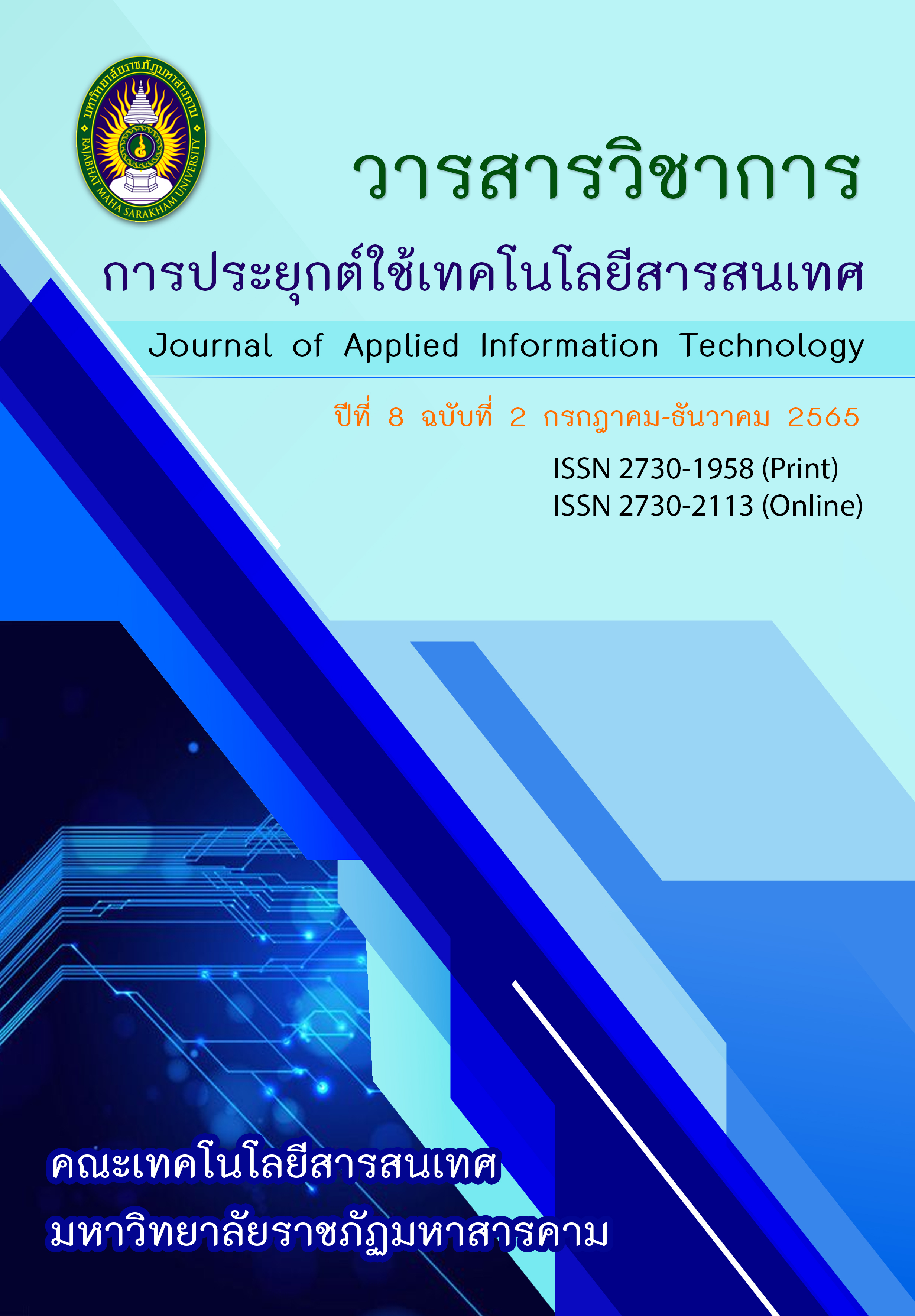การพัฒนาเว็บแอปพลิเคชันเพื่อจำแนกกล้วยด่างด้วยเทคนิคการเรียนรู้ของเครื่อง
Main Article Content
บทคัดย่อ
งานวิจัยเรื่องการพัฒนาเว็บแอปพลิเคชันเพื่อจำแนกกล้วยด่างด้วยเทคนิคการเรียนรู้ของเครื่อง นำเสนอเทคนิคการเรียนรู้ของเครื่องแบบการเรียนรู้เชิงลึกด้วยอัลกอรึทึมคอนโวลูชันนิวรอนเน็ตเวิร์ค มาพัฒนาแบบจําลองการจำแนกและหาความสัมพันธ์ของกล้วยด่าง โดยมีวัตถุประสงค์เพื่อ 1) หาแบบจำลองการเรียนรู้ของเครื่อง (Model of Machine Learning) มาประยุกต์ใช้กับการจำแนกสายพันธุ์กล้วยด่าง 2) พัฒนาเว็บแอปพลิเคชันเพื่อจำแนกกล้วยด่างด้วยเทคนิคการเรียนรู้ของเครื่อง และ 3) หาประสิทธิภาพด้านความด้านความถูกต้องของแบบจำลองการเรียนรู้ ได้ดำเนินการเก็บรวบรวมข้อมูลภาพใบกล้วยด่างจากฐานข้อมูลขององค์การสวนพฤกษศาสตร์ จำนวน 5 สายพันธุ์ ได้แก่ 1) กล้วยฟอริด้าด่าง 2) กล้วยน้ำหว้าด่าง 3) กล้วยตานีด่าง 4) กล้วยเทพพนมด่าง และ 5) กล้วยแดงอินโดด่าง โดยแบ่งชุดข้อมูลสำหรับการสอนร้อยละ 70 และข้อมูลสำหรับทดสอบร้อยละ 30 จากนั้นใช้วิธีการเรียนรู้เขิงลึกด้วยอัลกอริทึมคอนโวลูชั่นนิวรอนเน็ตเวิร์คในการประมวลผลภาพเพื่อสร้างแบบจําลอง แล้วนำไปพัฒนาเว็บแอปพลิเคชันด้วยภาษาไพธอน โดยการวิจัยพบว่า 1) ได้แบบจำลองการเรียนรู้ของเครื่อง (Model of Machine Learning) มาประยุกต์ใช้กับการจำแนกสายพันธุ์กล้วยด่าง และ 2) ประสิทธิภาพด้านความด้านความถูกต้องของแบบจำลองการเรียนรู้ วัดด้วยวิธี F1 score ได้รับค่าความถูกต้องสูงสุดที่ 83.00
Article Details
เอกสารอ้างอิง
Nasteski, V. (2017). An overview of the supervised machine learning methods. Horizons, b, 4, 51-62.
Horn, W. (2001). AI in medicine on its way from knowledge-intensive to data-intensive systems. Artificial Intelligence in Medicine, 23(1), 5-12.
Guilherme, A. (2019). AI and education: the importance of teacher and student relations. AI & society, 34(1), 47-54.
Dharmaraj, V., & Vijayanand, C. (2018). Artificial intelligence (AI) in agriculture. International Journal of Current Microbiology and Applied Sciences, 7(12), 2122-2128.
Bruzzone, A., & Orsoni, A. (2003). AI and simulation-based techniques for the assessment of supply chain logistic performance. In 36th Annual Simulation Symposium. (pp. 154-164). IEEE.
Li, S., Song, W., Fang, L., Chen, Y., Ghamisi, P., & Benediktsson, J. A. (2019). Deep learning for hyperspectral image classification: An overview. IEEE Transactions on Geoscience and Remote Sensing, 57(9), 6690-6709.
Rawat, W., & Wang, Z. (2017). Deep convolutional neural networks for image classification: A comprehensive review. Neural computation, 29(9), 2352-2449.
Kamilaris, A., & Prenafeta-Boldú, F. X. (2018). A review of the use of convolutional neural networks in agriculture. The Journal of Agricultural Science, 156(3), 312-322.
จักรินทร์ สนุกแสน, โอฬาริก สุรินต๊ะ. (2019). โครงข่ายประสาทเทียมแบบคอนโวลูชั่นเชิงลึกสำหรับการจำแนกพรรณไม้ที่อยู่ใน สิ่งแวดล้อมทางธรรมชาติ. Journal of Science & Technology MSU, 38(2).
WONGBONGKOTPAISAN, J., & PHUMEECHANYA, S. (2021). Development of Plant Diseases Classification Method sing Deep Learning (Doctoral dissertation, Silpakorn University).
Jonburom, W., Angkawisittpan, N., Nuan-On, A., & Ooi, P. C. (2022). Wind Speed Prediction using Artificial Neural Networks Based on Grey Wolf Optimizer. Engineering Access, 8(1), 45-52.
Burch, C. (2010). Django, a web framework using python: Tutorial presentation. Journal of Computing Sciences in Colleges, 25(5), 154-155.
Burch, C. (2010). Django, a web framework using python: Tutorial presentation. Journal of Computing Sciences in Colleges, 25(5), 154-155.
Fang, Q., & Boas, D. A. (2009). Tetrahedral mesh generation from volumetric binary and grayscale images. In IEEE international symposium on biomedical imaging: from nano to macro (pp. 1142-1145). Ieee.
Dhillon, A., & Verma, G. K. (2020). Convolutional neural network: a review of models, methodologies and applications to object detection. Progress in Artificial Intelligence, 9(2), 85-112.
LeCun, Y., Bengio, Y., & Hinton, G. (2015). Deep learning. nature, 521(7553), 436-444.


